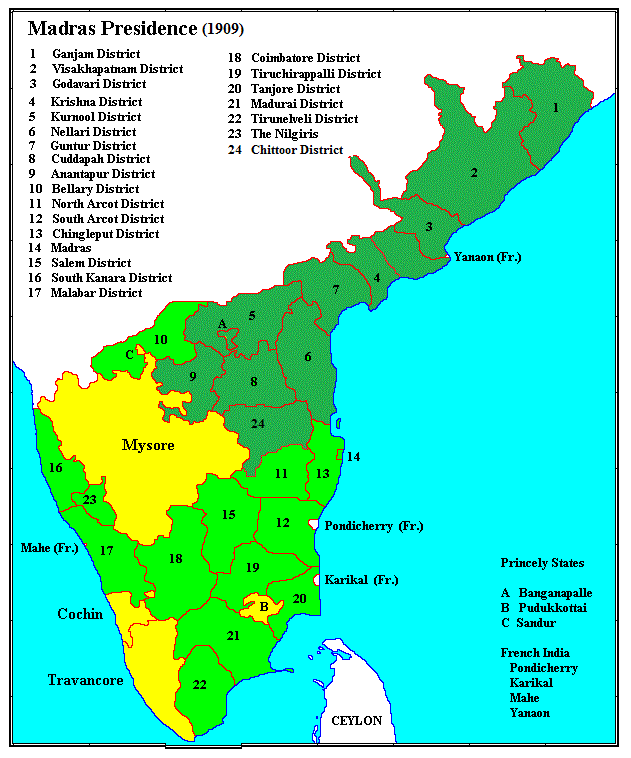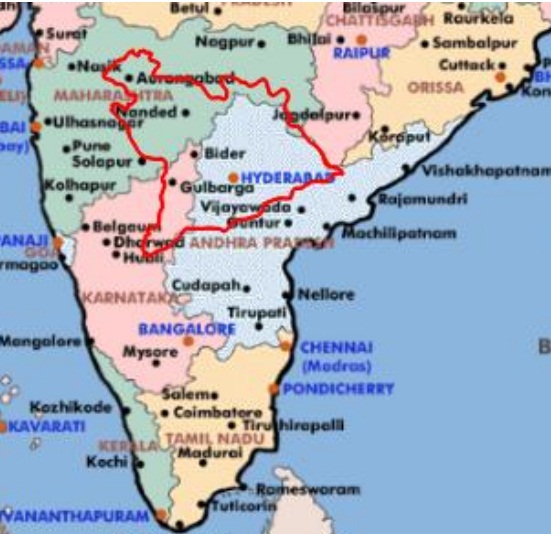There are a lot of myths and huge ignorance surrounding the formation of Andhra Pradesh. People generally assume that it was historically one through time. However, Andhra Pradesh witnessed many changes before it emerged as the first linguistic state on November 1, 1956. The years 1947 to 1956 were very crucial in the history of Andhra Pradesh. When India got independence on August 15, 1947, the three main regions of Andhra Pradesh – Coastal Andhra, Rayalaseema and Telangana were not part of Andhra Pradesh state.
Coastal Andhra and Rayalaseema belonged to Madras Presidency as a province of British India. Telangana was part of Hyderabad state, which was an independent native Indian state. Though, there were 568 native Indian states, Hyderabad State was the most important native state and was administered directly by the Governor General of India.

Madras Presidency (in green color) - 1909. The area in darker shade of green represents Coastal Andhra and Rayalaseema regions
The ruler of Hyderabad State was considered the most senior or superior native Indian ruler. Hyderabad state included Telangana, 4 Kannada districts in Gulberga division & 4 Marathi districts in Aurangabad division.
There was a big difference between these two regions. Unlike Madras Presidency, Hyderabad state was not under direct British rule. The law of Madras Presidency rested upon the laws passed by the British Parliament. In contrast, Hyderabad state had its own law. English was the official language of Madras Presidency, where as it was Urdu for Hyderabad state. Which means all records were kept only in Urdu (for this reason the old land records are in Urdu). The maintenance of all records in Urdu is symbolic of the differences between the two vastly different administrative systems. Urdu was a compulsory subject in Hyderabad state and almost all educated people knew Urdu like people know English today.
Hyderabad state had its own financial, military, judicial, police, general, public works and revenue departments.
The administration of Rayalseema and Coastal Andhra mostly followed the current system in India that was derived from British administration systems. Whereas Hyderabad State followed the Moghul administration systems (with changes made over time).
Nizam wants Hyderabad State to be an independent country – refuses to join Indian Union
Though India got independence on 15th August 1947, till 18th September 1948 (i.e., 1 year, 1 month and 4 days later) it was not part of the Indian Union. The last Nizam of Hyderabad resisted Indian government’s efforts to merge Hyderabad state into the Indian Union. He even approached the United Nations for recognition of Hyderabad State as a separate country. Indian Union’s negotiations with the Nizam were abortive. The Nizam Government refused to accede his territory to Indian Union.
Coastal Andhra and Rayalseema are administered as part of Madras Presidency (1947-1952)
Meanwhile, after India became independent on August 15, 1947, Ramaswamy Reddiyar was the first Chief Minister of Madras state (Coastal Andhra and Rayalseema regions are part of Madras State). Poosapati Sanjeevi Kumarswamy Raja was the Chief Minister of Madras Presidency from April 6, 1949 to April 10, 1952. Madras State was the name by which Madras Presidency was known from January 26, 1950.
Merger of Hyderabad state into Indian Union
Government of India launched ‘Police Action’ code named ‘Operation Polo’ on September 13, 1948 against Nizam. Nizam’s forces surrendered within five days on 18 September 1948 and the merger of Hyderabad state into the Indian Union announced formally. For full details about the liberation of Hyderabad, please click here.

Hyderabad State post merger with India
Until the end of 1949, Major-General J.N.Chaudhuri was the Military Governor of Hyderabad. The government of India appointed M. K. Vellodi as a Chief Minister of Hyderabad state in 26 January 1950 (Republic day) till 6th March 1952 i.e. the completion of the first elections in Independent India. He was a Senior Civil servant in the Government of India. The Nizam was designated ‘Raj Pramukh’ in January 1950 (resigned in 1956, when Hyderabad was split along linguistic lines).
Indian leaders consider and abandon the formation of linguistic States immediately after independence
At Independence, India was a fledgling and vulnerable nation that was created by a partition on religious lines, tested by communal riots across North India and a war in Kashmir. Even the respected British Prime Minister Winston Churchill said, “India is a geographical term. It is no more a united nation than the Equator.” The leaders of India started considering the idea of linguistic state to consolidate and give a new identity to the fledgling nation. Moreover, the demarcation of the states (called provinces in British India) was based on history and to maintain the princely states. As a modern democracy, this structure was no longer relevant.
The Government of India formed ‘The Dar Commission’ under the Chairmanship of S.K.Dar, which did not recommend the creation of States on the linguistic criteria. This drew adverse reactions in the Telugu speaking regions. The Congress Party immediately constituted an unofficial Committee consisting Jawaharlal Nehru, Vallabhbhai Patel and Pattabhi Sitaramaiah, popularly known as the J.V.P. Committee. In April 1949, the Committee recommended that the creation of linguistic provinces should be postponed by few years.
First Elections in Free India (1952)
The first general elections are held in India in 1952. Elections were held both for state and central government. Coastal Andhra and Rayalseema went to elections under the Madras State. Hyderabad State goes to elections separately.
Dr. Burgula Ramakrishna Rao was elected as a chief minister of Hyderabad state
Elections were held for the Hyderabad State in 1952 general elections. Of the 175 MLA seats, Congress wins 93. Left leaning parties like People Democratic Front(42), peasants & workers party of India(10), Socialist party of India(10) and independents(15) are the other major seat winners. Burgula Rama Krishna Rao took charge as Chief Minister of the Hyderabad state after 1952 general elections.
Elections in Coastal Andhra and Rayalseema regions are held as part of Madras State. Congress forms government with C Rajagopalachari as the chief minister.
Coastal Andhra and Rayalaseema form Andhra State
Potti Sri Ramulu one of the strong leaders of the separate Andhra movement, took indefinite fasting from October 19, 1952 demanding for a separate Andhra state from the Madras state for the Telugus. On December 15, Potti Sri Ramulu breathed his last breath in the fasting camp. As the news of his death broke, violence spread all over the southern parts of the country. As a result of Potti Sri Ramulu’s sacrifice, the Prime Minister Jawaharlal Nehru inaugurated the Andhra state consisting eleven districts of Coastal Andhra and Rayalaseema on October 1, 1953 with Kurnool as its capital city.
The Formation of Andhra Pradesh
However, Telugu speaking people demanded for their long cherished Visalandhra formation, but people of Hyderabad state were unanimous in their demand for splitting the state into three parts. The States Reorganization Commission headed by Syed Fazal Ali heard the views of different people and organizations. Based on the Commission’s conclusions, the Congress Party High Command preferred Visalandhra and enlarged the state by including nine Telugu speaking districts of Hyderabad state to eleven districts of Andhra state to form Andhra Pradesh with 20 districts. In the process, the Hyderabad state was split among Maharashtra, Karnataka and Andhra State. Aurangabad division merged with Maharashtra and Gulbarga division merged with Karnataka. The rest of the two divisions of the state – Gulshanabad or Medak and Nizamabad merged with Andhra State.
Thus, the state of ‘Andhra Pradesh’ emerged merging all the districts of Coastal Andhra, Rayalaseema and Telangana on November 1, 1956, with Neelam Sanjiva Reddy as the Chief Minister and C.M Trivedi as the Governor.
Suggested Reading:
Liberation of Hyderabad State
Hyderabad Little Known History
Significant Contributors to Hyderabad City




